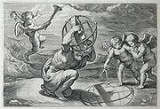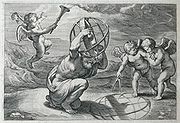
François d'Aguilon
Encyclopedia
François d'Aguilon (4 January 1567, Brussels
– 20 March 1617, Tournai
), was a Belgian
Jesuit mathematician
, physicist
and architect
.
He became a Jesuit in 1586. In 1611, he started a special school of mathematics
, in Antwerp, which intended to perpetuate the mathematical research and study in the Jesuit society. This school produced geometers like André Tacquet
and Jean Charles della Faille.
 His book, Opticorum Libri Sex philosophis juxta ac mathematicis utiles (Six Books of Optics, useful for philosophers and mathematicians alike), published in Antwerp in 1613, was illustrated by famous painter Peter Paul Rubens. It was notable for containing the principles of the stereographic
His book, Opticorum Libri Sex philosophis juxta ac mathematicis utiles (Six Books of Optics, useful for philosophers and mathematicians alike), published in Antwerp in 1613, was illustrated by famous painter Peter Paul Rubens. It was notable for containing the principles of the stereographic
and the orthographic
projections, and it inspired the works of Desargues and Christiaan Huygens.
He died in Antwerp.
Brussels
Brussels , officially the Brussels Region or Brussels-Capital Region , is the capital of Belgium and the de facto capital of the European Union...
– 20 March 1617, Tournai
Tournai
Tournai is a Walloon city and municipality of Belgium located 85 kilometres southwest of Brussels, on the river Scheldt, in the province of Hainaut....
), was a Belgian
Demographics of Belgium
This article is about the demographic features of the population of Belgium, including ethnicity, education level, health of the populace, economic status, religious affiliations and other aspects of the population...
Jesuit mathematician
Mathematician
A mathematician is a person whose primary area of study is the field of mathematics. Mathematicians are concerned with quantity, structure, space, and change....
, physicist
Physicist
A physicist is a scientist who studies or practices physics. Physicists study a wide range of physical phenomena in many branches of physics spanning all length scales: from sub-atomic particles of which all ordinary matter is made to the behavior of the material Universe as a whole...
and architect
Architect
An architect is a person trained in the planning, design and oversight of the construction of buildings. To practice architecture means to offer or render services in connection with the design and construction of a building, or group of buildings and the space within the site surrounding the...
.
He became a Jesuit in 1586. In 1611, he started a special school of mathematics
Mathematics
Mathematics is the study of quantity, space, structure, and change. Mathematicians seek out patterns and formulate new conjectures. Mathematicians resolve the truth or falsity of conjectures by mathematical proofs, which are arguments sufficient to convince other mathematicians of their validity...
, in Antwerp, which intended to perpetuate the mathematical research and study in the Jesuit society. This school produced geometers like André Tacquet
André Tacquet
André Tacquet was a Flemish mathematician and Jesuit Priest. His work prepared ground for the eventual discovery of the calculus....
and Jean Charles della Faille.

Stereographic projection
The stereographic projection, in geometry, is a particular mapping that projects a sphere onto a plane. The projection is defined on the entire sphere, except at one point — the projection point. Where it is defined, the mapping is smooth and bijective. It is conformal, meaning that it...
and the orthographic
Orthographic projection
Orthographic projection is a means of representing a three-dimensional object in two dimensions. It is a form of parallel projection, where all the projection lines are orthogonal to the projection plane, resulting in every plane of the scene appearing in affine transformation on the viewing surface...
projections, and it inspired the works of Desargues and Christiaan Huygens.
He died in Antwerp.

